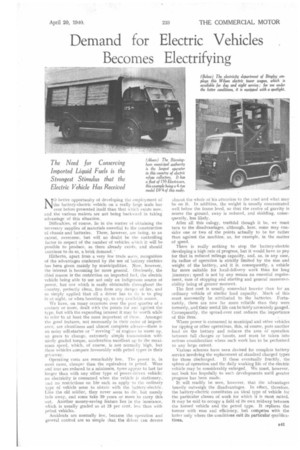Demand for Electric Vehicles Becomes Electrifying
Page 59

If you've noticed an error in this article please click here to report it so we can fix it.
The Need for Conserving Imported Liquid Fuels is the Strongest Stimulus that the Electric Vehicle Has Received
INthe better opportunity of developing the employment of the battery-electric vehicle on a really large scale has ever before presented itself than that which exists now, and the various makers are not being backward in taking advantage of this situation,
Difficulties, of course, lie in the matter of obtaining the necessary supplies of materials essential to the construction of chassis and batteries. These, however, arc being, to an extent, overcome, but will no doubt be the controlling factor in respect of the number of vehicles which it will be possible to produce, as there already exists, and should continue to do so, a brisk demand.
Hitherto, apart from a very few trade users, recognition of the advantages conferred by the use of battery electrics has been given mainly by municipalities. Now, however, the interest is becoming far more general. Obviously, the chief reason is the restriction on imported fuel, the electric vehicle being able to use not only an indigenous source of power, but one which is easily obtainable throughout the country, perfectly clean, free from any clanger of fire, and so simply applied' that all a driver has to do is to plug in at night, or when boosting up, to any available source.
We have, on many occasions over the past quarter of a century or more, dealt With the points for and against the type, but with the expanding interest it may be worth while to refer to at least the most important of these. Amongst the good features, not necessarily in their order of importance, are cleanliness and almost complete silence—there is ao noisy self-starter or " revving " of engines to warm up, no gears to change, extremely simple transmission with nicely graded torque, acceleration excellent up to the maximum speed, which, of course, is not normally high, but these vehicles compare favourably with petrol types in their get-away.
Operating costs are remarkably low, The power is, in most cases, cheaper than the equivalent in petrol. Wear and tear are reduced to a minimum, tyres appear to last far longer than with any other type of power-driven vehicle; no electricity is consumed when the vehicle is stationary, and no restrictions on life such as apply to the ordinary type of vehicle seem to obtain with the battery-electric. Like the old soldier, they never seem to die, but merely fade away, and some take 20 years or more to carry this out, Another money-saving feature lies in the insurance, which is usually graded as at 25 per cent, less than with petrol vehicles.
Accidents are normally few, because the operation and general control are so simple that the driver can devote
almost the whole of his attention to the road and what may be on it. In addition, the weight is usually concentrated well below the frame level, so that the centre of gravity is nearer the ground, sway is reduced, and skidding, consequently, less likely.
After all this eulogy, truthful though it be, we must turn to the disadvantages, although, here, some may consider one or two of the points actually to be for rather than against the machine, as, for example, in the matter of speed.
There is really nothing to stop the battery-electric developing a high rate of progress, but it would have to pay for that in reduced mileage capacity, and, as, in any case, its radius of operation is strictly limited by the size and weight of the battery, and it is, .consequently, a vehicle far more suitable for local-delivery work than for long journeys ; speed is not by any means an essential requirement, ease of stopping and starting and general manceuvrability being of greater moment.
The first cost is usually somewhat heavier than for an ordinary vehicle of similar load capacity. Much of this must necessarily be attributed to the batteries. Fortunately, these are now far more reliable than they were formerly, and, their useful life can be fairly accurately gauged. Consequently. the spread-over cost reduces the importance of this item.
Where power is consumed in municipal and other vehicles for tipping or other operations, this, of course, puts another load on the battery and reduces the area of operation between full charges or boosts, and must be taken into serious consideration where such work has to be performed to any large extent.
Various schemes have men devised for complete battery service involving the replacement of standard charged types for those discharged. If these eventually fructify, the sphere of operation and the daily working life of the electric vehicle may be considerably enlarged. We must, however, not look too hopefully to such developments until greater progress has been made.
It will readily be seen, however, that the advantages heavily outweigh the disadvantages. In effect, therefore, the battery-electric constitutes an ideal type of vehicle for the particular classes of work for which it is most suited. It may be said to occupy a field of its own midway between the horsed vehicle and the petrol type. It replaces the former with ease and efficiency, but competes with the latter only where the conditions suit its particular qualifications.




































































































